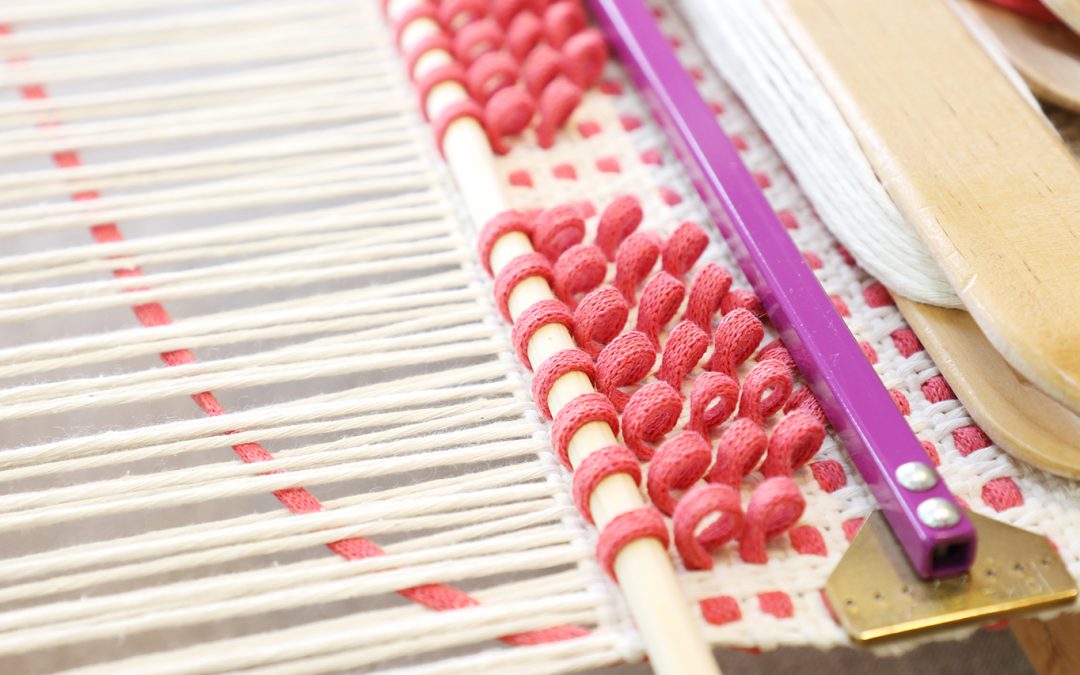Picking technique is easy!
| The warp | Minimop Cotton Twine, natural white 1 kg = approx. 700 m, Ø 2,5 mm, 80 % recycled cotton, 20 % polyester, Lankava |
| Warp | width 60 cm density 3 threads/cm amount of warp ends 181 amount of yarn needed 1,27 kg |
| Length | 4,8 m |
| Reed | 30/1 |
| Weave | Weft looped weave, tabby |
| The weft | Minimop Cotton Twine and Lilli Tube Yarn |
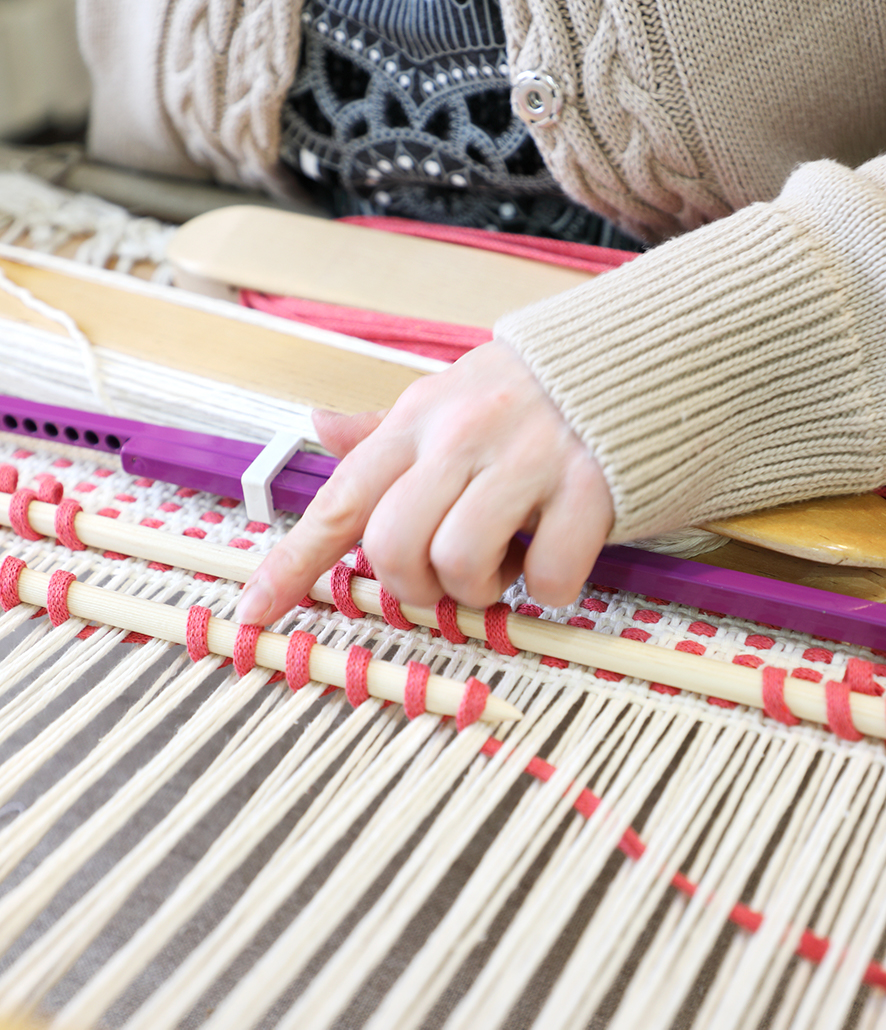
Picking up loops
1. Shuttle in two background wefts.
2. Shuttle in the heavier looping weft. Hold the shed open and start to pull up loops starting from the same side you shuttled the weft in. There are three rising and two descending warp threads in the shed. Pick up the loops on the rod between the rising warp threads according to the plan. Do not draw out the rod yet!
3. Shuttle in two background wefts.
4. Shuttle in the looping weft and pull the loops on the rod starting from the same side you shuttled the weft in. Wind the loop on the rod to the same angle as on the previous row.
5. Shuttle in two background wefts.
6. Draw out the earlier rod and continue weaving. Keep the rods in the weave as long as possible to avoid loops loosening.
Weaving tips for looping
> Keep the warp tension tight.
> Beat firmly. Background wefts secure the loops.
> Wind every loop into the same tension on the rod.
> Do not twist the looping weft and background weft on the edges. The looping weft doesn’t go around the two outmost warp ends. At the beginning start the looping weft by turning the tail back in the shed around the third warp thread from the edge.
> Overlap the old and new looping weft for 10 cm, leave about 5 cm tails to the reverse side. Place the new weft on the old weft when overlapping. When finishing, fasten the tail with few stitches to the weft below and cut the tails. You can leave the tails to the pillow fabrics.
It is also possible to draw weft ends through each other with a crochet hook when using tube yarn. Make sure that the joint is durable and secure it with stitches.
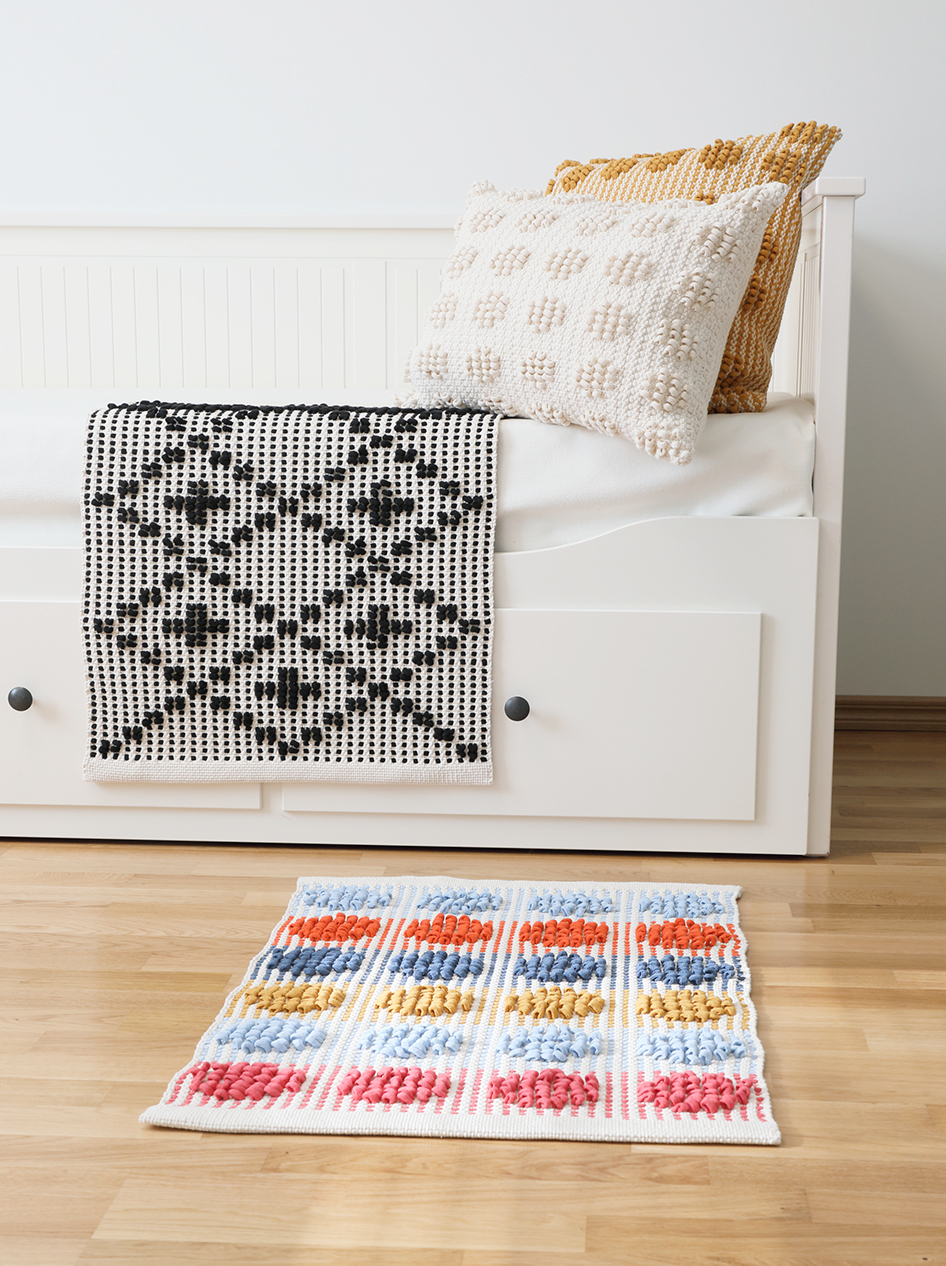
Pillows
WEAVING INSTRUCTIONS
Start and finish by weaving a 3 cm seam allowance using natural white Minimop cotton twine, plain weave.
Weave the pillow fabric using the Minimop cotton twine as background weft and Lilli tube yarn as looping thread. Weave white pillow fabric with natural white background and looping weft and yellow with the Lion Yellow wefts.
Shoot two background wefts between each looped weft. Pull the loops according to the plan on the left. Use a rod to pick up the loops, see instructions on the next page.
The density of the weave is approx. 1 Lilli Tube Yarn + 2 Minimop Cotton Twine/1 cm.
The woven length is 90 cm + seam allowance á 3 cm = 96 cm. The woven length is 80 cm + seam allowance á 3 cm = 86 cm.
The circumference of the rod is 0,8 cm.
FINISHING
Sew 3-step zigzag on the ends. Press using a damp pressing cloth from the reverse side. You can also wash the fabric.
Fold the fabric with right sides facing each other and sew the edges by hand using 6-ply cotton twine. Use a tapestry needle. Leave the seam allowance as narrow as possible. Do not punch the threads but take the whole thread on the needle. Turn the pillow right side out, insert the pad and stitch the opening to close. Use a needle to pick up the warp threads alternately from both sides. Stay on the same weft rows and you get an even plain weave surface.
White pillow
Finished size 50 x 40 cm
AMOUNT OF WEFT YARN NEEDED
Minimop Cotton Twine, 1 kg = approx. 700 m, Ø 2,5 mm,
80 % recycled cotton, 20 % polyester, Lankava
52 natural white 170 g
Lilli Tube Yarn, 1 kg = approx. 220 m, recycled cotton,
20 % polyester, Lankava
2 natural white 305 g
Yellow pillow
Finished size 50 x 50 cm
AMOUNT OF WEFT YARN NEEDED
Minimop Cotton Twine, 1 kg = approx. 700 m, Ø 2,5 mm,
80 % recycled cotton, 20 % polyester, Lankava
71 Lion Yellow 200 g
Lilli Tube Yarn, 1 kg = 220 m, recycled cotton, 20 % polyester,
21 Lion Yellow 360 g




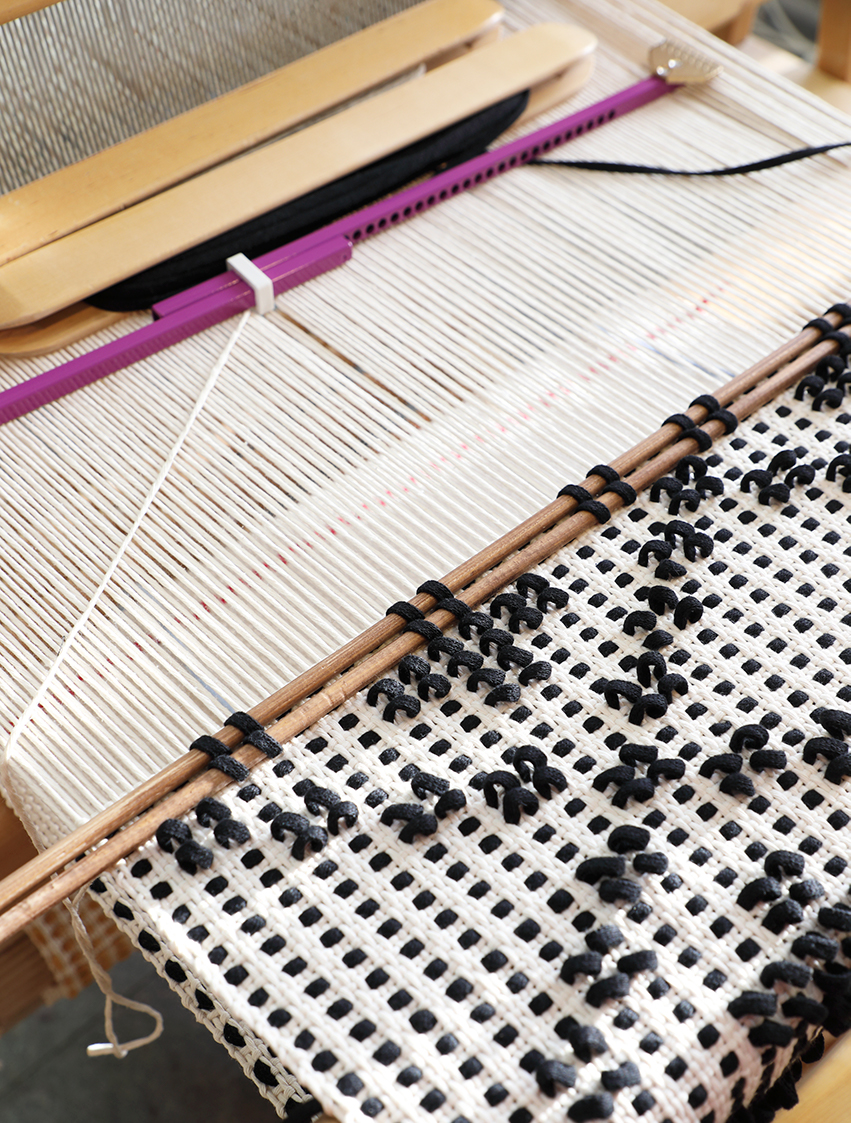
Small rugs
WEAVING INSTRUCTIONS
Weave 8 cm for the border using natural white Minimop cotton twine. The plain weave border is wider than the rug. Alternatively you can leave fringes or weave just about 3 cm for the border and then fold it completely on the reverse side.
Weave the rug using the natrural white Minimop cotton twine as a background weft and heavier Lilli tube yarn as a pattern weft. Keep the warp tension tight. Density of the weave is approx. 1 Lilli tube yarn + 2 Minimop cotton twine/1 cm. See weaving tips on page 19.
FINISHING
Sew 3-step zigzag on the ends. Fasten the pattern weft tails on the reverse side with a few stitches to the weft below before cutting. Press the rug through a damp cloth on the reverse side (or steam). Sew the borders by hand using 6-ply cotton twine. Do not pierce the threads but take the whole thread on the needle. Machine-wash 40oC and spin about 1200 rpm, or wash according to the materials you used and observe the structure of the fabric. Dry flat in an airy and warm place, the fabric dries slowly.
Small rug balloons
Finished size 50 x 74 cm, washed
The woven length in loom is 80 cm + borders á 8 cm = 96 cm. The length when taken off the loom is 72 cm + borders á 7 cm = 86 cm.
The circumference of the rod was 1 cm.
AMOUNT OF WEFT YARN NEEDED
Minimop Cotton Twine, 1 kg = approx. 700 m, Ø 2,5 mm,
80 % recycled cotton, 20 % polyester, Lankava
52 natural white 191 g
Lilli Tube Yarn, 1 kg = approx. 220 m, recycled cotton,
20 % polyester
12 coral red 57 g
18 light blue 118 g
21 lion yellow 55 g
22 smoky blue 48 g
8 orange 57 g
Small rug diamonds
Finished size 50 x 68 cm, washed
The woven length in loom is 73 cm + borders á 8 cm = 89 cm. The length when taken off the loom 66 cm + borders á 7 cm = 80 cm.
The circumference of the rod was 0,8 cm.
AMOUNT OF WEFT YARN NEEDED
Minimop Cotton Twine, 1 kg = approx. 700 m, Ø 2,5 mm,
80 % recycled cotton, 20 % polyester, Lankava
52 natural white 170 g
Lilli Tube Yarn, 1 kg = 220 m, recycled cotton, 20 % polyester
20 black 245 g



DIY Picking rods
– Sand the end until it is smooth. You need at least 2 rods and they must be wider than the warp.
– 0,8 – 1 cm circumference is suitable for these heavy weaves.
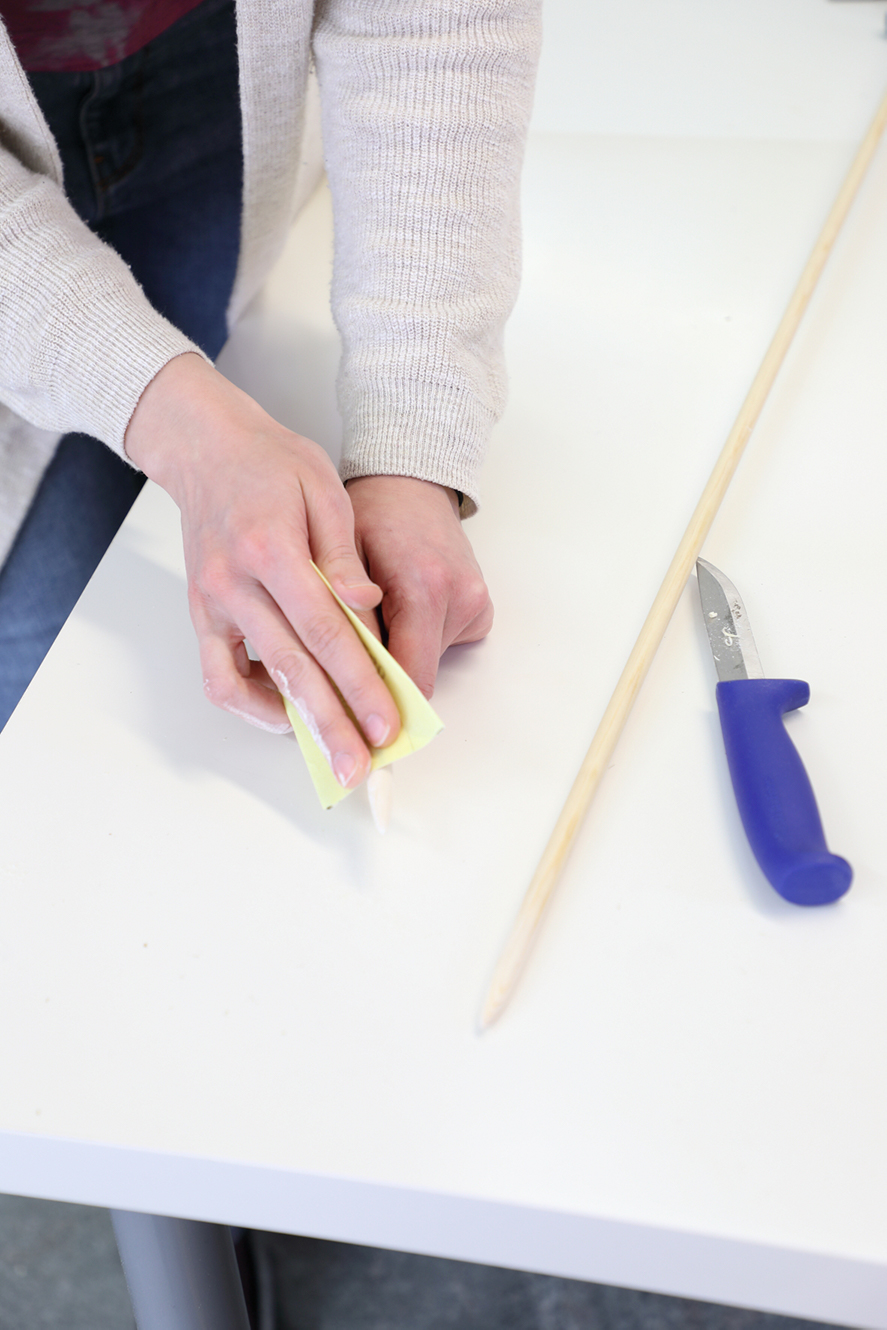
You can use knitting needles for picking if you weave with yarns thinner than these cotton twines.



